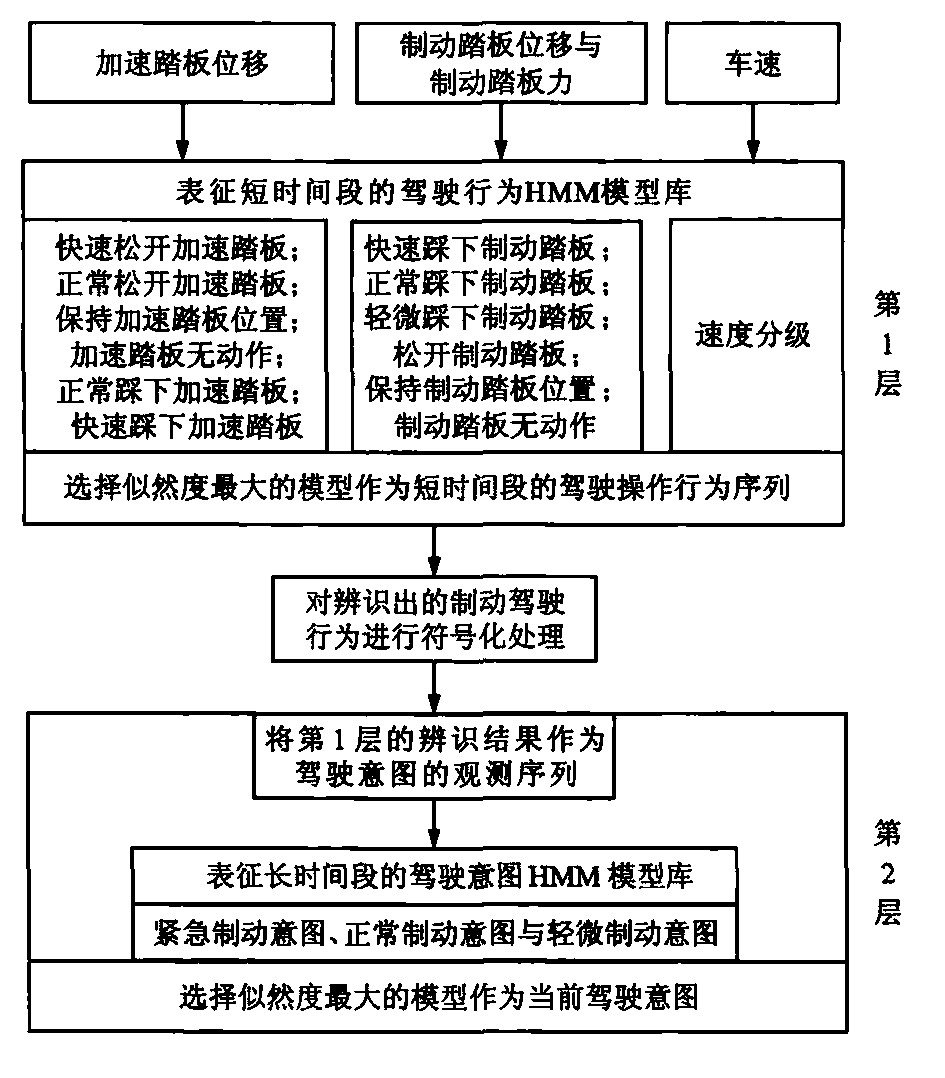Composite braking control strategy of pure electric bus based on brake driving intention recognition
-
摘要: 为了研究纯电动客车复合制动系统制动力分配比例, 提出了基于制动驾驶意图辨识的复合制动控制策略。基于隐形马尔科夫理论建立了双层制动驾驶意图辨识模型, 运用道路试验数据对模型进行辨识验证。基于辨识出的驾驶意图和车速, 以前后轮制动力分配比例、ECE法规、电机特性、滑移率、蓄电池特性、超级电容特性与传动系统特性为约束条件, 制定了复合制动系统制动力分配策略, 在9种工况下, 应用Simulink对复合制动系统进行建模仿真。仿真结果表明: 应用基于制动驾驶意图的纯电动客车复合制动控制策略后, 在各种工况下, 摩擦制动系统和电机再生制动系统能够协调稳定地工作, 在保证制动安全性的前提下最大限度地回收了制动能量。低车速轻微制动时能量回收效率最高, 可达到43.84%。高车速紧急制动时能量回收效率最低, 仅为0.89%。Abstract: To research braking force distribution ratio of composite braking system for pure electric bus, a composite braking control strategy based on brake driving intention recognition was presented.A double-layer brake driving intention recognition model based on hidden Markov theory was set up and identified by using road experiment data.Based on recognized driving intention and vehicle speed, the distribution ratios of braking forces for front and rear wheels, ECE regulation, motor characteristics, slip ratios, battery characteristics, super capacitor characteristics and transmission system characteristics were taken as constraint conditions, the braking force distribution strategy of composite braking system was proposed, and the control strategy of composite braking system was simulated by Simulink software under 9 operating conditions.Simulation result shows that friction braking system and motor regenerative braking system can work coordinately and steadily under various operating conditions when the braking control strategy is applied, and braking energy can be recovered as much as possible under the premise of ensuring braking safety.Energy recovery efficiency is highest under slight brake when vehicle speed was low, and the efficiency can reach to 43.84%.Energy recovery efficiency is lowest under emergency brake when vehicle speed is high, and the efficiency is only 0.89%.
-
表 1 逻辑规则
Table 1. Logic rules

表 2 仿真结果
Table 2. Simulation result

-
[1] 曹秉刚, 张传伟, 白志峰, 等. 电动汽车技术进展和发展趋势[J]. 西安交通大学学报, 2004, 38(1): 1-5. https://www.cnki.com.cn/Article/CJFDTOTAL-XAJT200401001.htmCAO Bing-gang, ZHANG Chuan-wei, BAI Zhi-feng, et al. Technology progress and trends of electric vehicles[J]. Journal of Xi'an Jiaotong University, 2004, 38(1): 1-5. (in Chinese). https://www.cnki.com.cn/Article/CJFDTOTAL-XAJT200401001.htm [2] CHAN C C, WONG Y S. The state of the art of electric vehicles technology[C]//IEEE. The 4th International Power Electronics and Motion Control Conference. Xi'an: Xi'an Jiaotong University Press, 2004: 46-57. [3] SCHMIDT M, ISERMANN R, LENZEN B, et al. Potential of regenerative braking using an integrated starter alternator[J]. SAE Paper, 2000-01-1020. [4] 彭栋. 混合动力汽车制动能量回收与ABS集成控制研究[D]. 上海: 上海交通大学, 2007.PENG Dong. Study on combined control of regenerative braking and anti-lock braking system for hybrid electric vehicle[D]. Shanghai: Shanghai Jiaotong University, 2007. (in Chinese). [5] ZHANG J Z, CHEN X, ZHANG P J. Integrated control of braking energy regeneration and pneumatic anti-lock braking[J]. Journal of Automobile Engineering, 2010, 224(5): 587-610. doi: 10.1243/09544070JAUTO1307 [6] 张昌利, 张亚军, 闫茂德, 等. 双能量源纯电动汽车再生制动模糊控制与仿真[J]. 系统仿真学报, 2011, 23(2): 233-238. https://www.cnki.com.cn/Article/CJFDTOTAL-XTFZ201102004.htmZHANG Chang-li, ZHANG Ya-jun, YAN Mao-de, et al. Fuzzy control modeling and simulation of regenerative braking system for pure electric vehicle with dual-source energy storage system[J]. Journal of System Simulation, 2011, 23(2): 233-238. (in Chinese). https://www.cnki.com.cn/Article/CJFDTOTAL-XTFZ201102004.htm [7] WALKER A M, LAMPERTH M U, WILKINS S. On friction braking demand with regenerative braking[J]. SAE Paper, 2002-01-2581. [8] 周磊, 罗禹贡, 李克强, 等. 电动汽车回馈制动与防抱死制动集成控制[J]. 清华大学学报: 自然科学版, 2009, 49(5): 728-732. doi: 10.3321/j.issn:1000-0054.2009.05.027ZHOU Lei, LUO Yu-gong, LI Ke-qiang, et al. Braking control of electric vehicles while coordinating regenerative and antilock brakes[J]. Journal of Tsinghua University: Science and Technology, 2009, 49(5): 728-732. (in Chinese). doi: 10.3321/j.issn:1000-0054.2009.05.027 [9] KO J, KIM J, LEE G, et al. Development of a co-operative control algorithm during regenerative braking for a fuel cell electric vehicle[C]//IEEE. The 7th IEEE Vehicle Power and Propulsion Conference. Chicago: IEEE, 2011: 7-13. [10] 张元才, 余卓平, 徐乐, 等. 基于制动意图的电动汽车复合制动系统制动力分配策略研究[J]. 汽车工程, 2009, 31(3): 244-249. doi: 10.3321/j.issn:1000-680X.2009.03.011ZHANG Yuan-cai, YU Zhuo-ping, XU Le, et al. A study on the strategy of braking force distribution for the hybrid braking system in electric vehicles based on braking intention[J]. Automotive Engineering, 2009, 31(3): 244-249. (in Chinese). doi: 10.3321/j.issn:1000-680X.2009.03.011 [11] 马其贞. 基于制动意图识别的制动能量回收控制算法研究[D]. 长春: 吉林大学, 2013.MA Qi-zhen. Study on regenerative brake control algorithm based on braking intention identification[D]. Changchun: Jilin University, 2013. (in Chinese). [12] 孙璐, 郁烨, 顾文钧. 基于PCA和HMM的汽车保有量预测方法[J]. 交通运输工程学报, 2013, 13(2): 92 98. http://transport.chd.edu.cn/article/id/201302014SUN Lu, YU Ye, GU Wen-jun. Car ownership prediction method based on principal component analysis and hiddenMarkov model[J]. Journal of Traffic and Transportation Engineering, 2013, 13(2): 92-98. (in Chinese). http://transport.chd.edu.cn/article/id/201302014 [13] 曹源, 马连川, 李旺. 铁道信号系统安全计算机状态监测方法[J]. 交通运输工程学报, 2013, 13(3): 107-112. http://transport.chd.edu.cn/article/id/201303015CAO Yuan, MA Lian-chuan, LI Wang. Monitoring method of safety computer condition for railway signal system[J]. Journal of Traffic and Transportation Engineering, 2013, 13(3): 107-112. (in Chinese). http://transport.chd.edu.cn/article/id/201303015 [14] 杨琦, 杨云峰, 冯忠祥, 等. 基于灰度理论和马尔科夫模型的城市公交客运量预测方法[J]. 中国公路学报, 2013, 26(6): 169-175. doi: 10.3969/j.issn.1001-7372.2013.06.023YANG Qi, YANG Yun-feng, FENG Zhong-xiang, et al. Prediction method for passenger volume of city public transit based on grey theory and Markov model[J]. China Journal of Highway and Transport, 2013, 26(6): 169-175. (in Chinese). doi: 10.3969/j.issn.1001-7372.2013.06.023 [15] 张良力. 面向安全预警的机动车驾驶意图识别方法研究[D]. 武汉: 武汉理工大学, 2011.ZHANG Liang-li. Research on motorist's intention recognition for traffic safety precaution[D]. Wuhan: Wuhan University of Technology, 2011. (in Chinese). [16] 王臻. 基于分层隐马尔科夫模型的聚众事件实时检测[D]. 桂林: 桂林电子科技大学, 2010.WANG Zhen. Real time gathering event detection based on layered hidden Markov model[D]. Guilin: Guilin University of Electronic Technology, 2010. (in Chinese). [17] SATHYANARAYANA A, BOYRAZ P, HANSEN J H L. Driver behavior analysis and route recognition by hidden Markov models[C]//IEEE. 2008 IEEE International Conference on Vehicular Electronics and Safety. Columbus: IEEE, 2008: 276-281. [18] ZONG Chang-fu, WANG Chang, YANG De-jun, et al. Driving intention identification and maneuvering behavior prediction of drivers on cornering[C]//IEEE. 2009 IEEE International Conference on Mechatronics and Automation. Changchun: IEEE, 2009: 4055-4060. [19] 宗长富, 王畅, 何磊, 等. 基于双层隐式马尔科夫模型的驾驶意图辨识[J]. 汽车工程, 2011. https://www.cnki.com.cn/Article/CJFDTOTAL-QCGC201108013.htm33(8): 701-706. ZONG Chang-fu, WANG Chang, HE Lei, et al. Driving intention recognition based on double-layer HMM[J]. Automotive Engineering, 2011, 33(8): 701-706. (in Chinese). https://www.cnki.com.cn/Article/CJFDTOTAL-QCGC201108013.htm [20] 尹安东, 赵韩, 张炳力. 微型电动轿车制动能量回收及控制策略的研究[J]. 合肥工业大学学报: 自然科学版, 2008, 31(11): 1760-1763, 1777. https://www.cnki.com.cn/Article/CJFDTOTAL-HEFE200811009.htmYIN An-dong, ZHAO Han, ZHANG Bing-li. Study on regenerative braking and control strategy for electric vehicles[J]. Journal of Hefei University of Technology: Natural Science Edition, 2008, 31(11): 1760-1763, 1777. (in Chinese). https://www.cnki.com.cn/Article/CJFDTOTAL-HEFE200811009.htm [21] ZHOU Yu-cai, CHEN Shi-an, WANG Jun-cheng. Two-acceleration-error-input proportional-integral-derivative control for vehicle active suspension[J]. Journal of Traffic and Transportation Engineering: English Edition, 2014, 1(3): 228-234. [22] 赵轩. 纯电动客车动力总成控制策略研究[D]. 西安: 长安大学, 2012.ZHAO Xuan. Study on control strategy for powertrain of pure electric bus[D]. Xi'an: Chang'an University, 2012. (in Chinese). [23] YAO Zuo, WEI Heng, PERUGU H, et al. Sensitivity analysis of project level MOVES running emission rates for light and heavy duty vehicles[J]. Journal of Traffic and Transportation Engineering: English Edition, 2014, 1(2): 81-96. -





 下载:
下载:






















